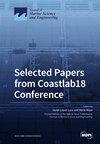The Volcanic Rocks and Hydrocarbon Accumulation in the Offshore Indus Basin, Pakistan
IF 2.8
3区 地球科学
Q1 ENGINEERING, MARINE
引用次数: 0
Abstract
To analyze the impact of volcanic rocks in the Offshore Indus Basin on hydrocarbon reservoir formation, seismic data interpretation, seismic data inversion, and sea–land correlation analysis were carried out. The results show that, longitudinally, volcanic rocks are mainly distributed at the top of the Cretaceous system or at the bottom of the Paleocene, and carbonate rock platforms or reefs of the Paleocene–Eocene are usually developed on them. On the plane, volcanic rocks are mainly distributed on the Saurashtra High in the southeastern part of the basin. In terms of thickness, the volcanic rocks revealed by drilling in Karachi nearshore are about 70 m thick. We conducted sparse spike inversion for acoustic impedance in the volcanic rock area. The results show that the thickness of the Deccan volcanic rocks in the study area is between 250 and 750 m which is thinning from southeast to northwest. Based on sea–land comparison and comprehensive research, the distribution of volcanic rocks in the Indian Fan Offshore Basin played a constructive role in the Mesozoic oil and gas accumulation in the Indus offshore. Therefore, in the Indian Fan Offshore Basin, attention should be paid to finding Mesozoic self-generated and self-stored hydrocarbon reservoirs and Cenozoic lower-generated and upper-stored hydrocarbon reservoirs.巴基斯坦近海印度河盆地的火山岩和碳氢化合物储量
为分析近海印度河盆地火山岩对油气成藏的影响,进行了地震资料解释、地震资料反演和海陆相关分析。结果表明,纵向上,火山岩主要分布在白垩系顶部或古新世底部,其上多发育古新世-始新世的碳酸盐岩平台或岩礁。在平面上,火山岩主要分布在盆地东南部的索拉什特拉高地上。就厚度而言,卡拉奇近岸钻探揭示的火山岩厚度约为 70 米。我们在火山岩区域进行了稀疏尖峰反演声阻抗。结果显示,研究区域的德干火山岩厚度在 250 米至 750 米之间,从东南向西北逐渐变薄。根据海陆对比和综合研究,印度扇近海盆地的火山岩分布对印度河近海中生代油气聚集具有建设性作用。因此,在印度扇近海盆地应注意寻找中生代自生自储油气藏和新生代下生上储油气藏。
本文章由计算机程序翻译,如有差异,请以英文原文为准。
求助全文
约1分钟内获得全文
求助全文
来源期刊

Journal of Marine Science and Engineering
Engineering-Ocean Engineering
CiteScore
4.40
自引率
20.70%
发文量
1640
审稿时长
18.09 days
期刊介绍:
Journal of Marine Science and Engineering (JMSE; ISSN 2077-1312) is an international, peer-reviewed open access journal which provides an advanced forum for studies related to marine science and engineering. It publishes reviews, research papers and communications. Our aim is to encourage scientists to publish their experimental and theoretical results in as much detail as possible. There is no restriction on the length of the papers. The full experimental details must be provided so that the results can be reproduced. Electronic files and software regarding the full details of the calculation or experimental procedure, if unable to be published in a normal way, can be deposited as supplementary electronic material.
 求助内容:
求助内容: 应助结果提醒方式:
应助结果提醒方式:


